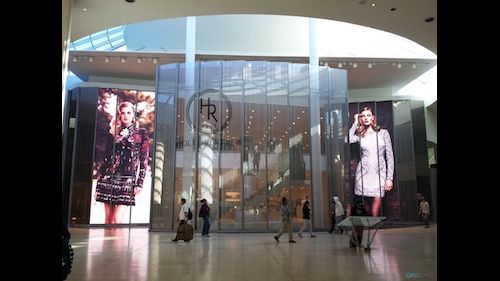Digital Display in the Omni-Channel Age

- For a few years now, the retail industry has been all about achieving “omni-channel,” or offering customers a seamless, personalized shopping experience, no matter if they contact a company online, in a store, through social media, or over the phone. Key to achieving this personalized experience is learning who a customer is and recognizing him at the point of contact. While retailers and the technology industries that support them have been busy spending immense amounts of time and resources to be able to figure out who customers are in real-time, the digital display industry has lagged behind when it comes to contributing to the omni-channel experience.
Nanolumens NanoSlim displays at a Holt Renfew store. This indifference to omni-channel is in spite of the impressive growth within the industry. Right now, the industry is doing about $18 billion in business annually. This includes everything from digital displays to content management, to the advertising that goes on the displays. And, according to IHS, digital signage saw a 10 percent increase in revenue in 2015. This growth rate is expected to continue through 2020.
But, just because the digital display industry has been late to the omni-channel party, doesn’t mean it’s skipping the event altogether. Rather, digital display is showing up fashionably late by embracing the new technologies that are entering the picture. These new technologies center on attribution and relevancy. Attribution is showing that the advertising is affecting the right consumers. Relevancy involves proving that advertising messages on a digital display are hitting a lot of eyeballs and are having an impact on the right consumers.
Some of the technologies that can provide this information to retailers through digital displays are:
Camera Sensors with Facial Algorithms: These sensors can understand how many people are looking at a display at any given time. They offer sophisticated analytics applications that capture in-store “dwell times,” responses to product displays, and traffic flow. For traditional brick-and-mortar retailers, this sort of intelligence has helped level the playing field with online sellers, who routinely track and profile their customers through cookies. Much of the excitement about facial recognition comes with putting a face to all those aggregated bits of data collected through loyalty programs, point-of-sale records, and other sources.
Bluetooth Beacons: A Bluetooth emitter within a store seeks an application on a customer’s phone. Once it latches onto the application, it’s able to access all of the information stored in the app about the customer. Retailers can use in-store beacons for many purposes. These Bluetooth devices collect customer data that can be used to improve shopping experiences and reduce customer wait times. It can also send out a marketing campaign based on that information. Currently, this technology is most commonly used for couponing, or making a customer a discount offer. But, the digital display industry is moving toward using the same beacon to change the message on the display to make it relevant to the customers in front of it—and hopefully persuade them to execute a sale in the store. When store owners utilize the features of in-store beacons, they can increase profits and understand their customers on a higher level. Consumers are more likely to return to a store if they have an enjoyable shopping experience. Digital age marketing is most successful when it is based on personalized experiences. In the future, in-store beacons will be a common practice for successful retailers.
LiFi: No, it’s not Wi-Fi. It’s LiFi, or the use of the visible light portion of the electromagnetic spectrum to transmit information. The digital display industry is beginning to use LED lights to track people in a store. Within the retail environment, LiFi is a pipeline that will enable all possible data transfer—from the store front-end, to in-store customer interaction, to back-office coordination, and customer services. It can even sync up with a warehouse and check for the required merchandise and place an advance inventory request. From the retailers’ perspective, imagine the possibility of directing customers right from the time they enter a store to the right position in the store—for the exact merchandise they are seeking.
While this new technology is certainly exciting, there are challenges. It’s not an easy feat to get all of these technologies to work together to create a seamless experience for customers. It is often intimidating for companies to implement all of this technology in a way that is scalable and create useful campaigns, instead of creating a tangled technological mess.

A Nanolumens hanging digital advertisement application in a shopping center.Integration of all of these technologies can become cumbersome to IT departments. Plus, integrating digital displays into a company’s omni-channel universe means that more departments have jurisdiction over the displays, including the marketing and IT departments, which can cause interdepartmental friction. The trick is to understand to whom to tailor the message if multiple people are looking at the display.
While the current use of these technologies could be described as piecemeal at best, digital signage as an industry is quickly reaching its maturity stage. Hitting the rapid growth stage for the implementation of these technologies is probably three or four years away. Complete integration will hit the big international cities like New York and Paris first, and then spread from there.
A daily selection of the top stories for AV integrators, resellers and consultants. Sign up below.
Still, there are companies that are beginning to do some interesting things out there. Fashion designer Rebecca Minkoff has done a good job of creating an immersive digital experience within her stores by installing digital mirrors. Target has shown the ability to use in-store beacons really well by deploying the technology to infuse its retail stores with the perks of online shopping. Holt Renfew and T-Mobile have also been pioneers in installing digital canvases in their stores.
It’s all about creating integration to facilitate an on-the-spot, useful customer interaction. Ideally, this technology would be connected into a company’s CRM system to help identify customers and message to them. This will allow for the digestion of big data so it can be turned into something immediately useful. The rise of millennials’ purchasing power will also accelerate the use of these technologies. Milennials are used to giving up their personal information to get something in return, like the option of having their lives become simpler.
What’s clear is that the integration of these technologies with other technologies like POS and CRM, and digital displays will create a retail force to be reckoned with—marketing platforms that can use biometrics, analytics, advertising messages, and sensors to drive sales through highly interactive stores. As today’s customers continue to demand an ever-more personalized retail experience, digital displays will play an increasingly greater role in the omni-channel experience.
Nate Remmes is vice president of corporate development at Nanolumens.
